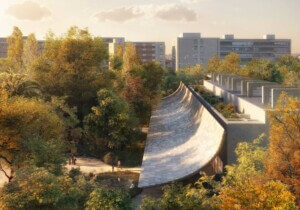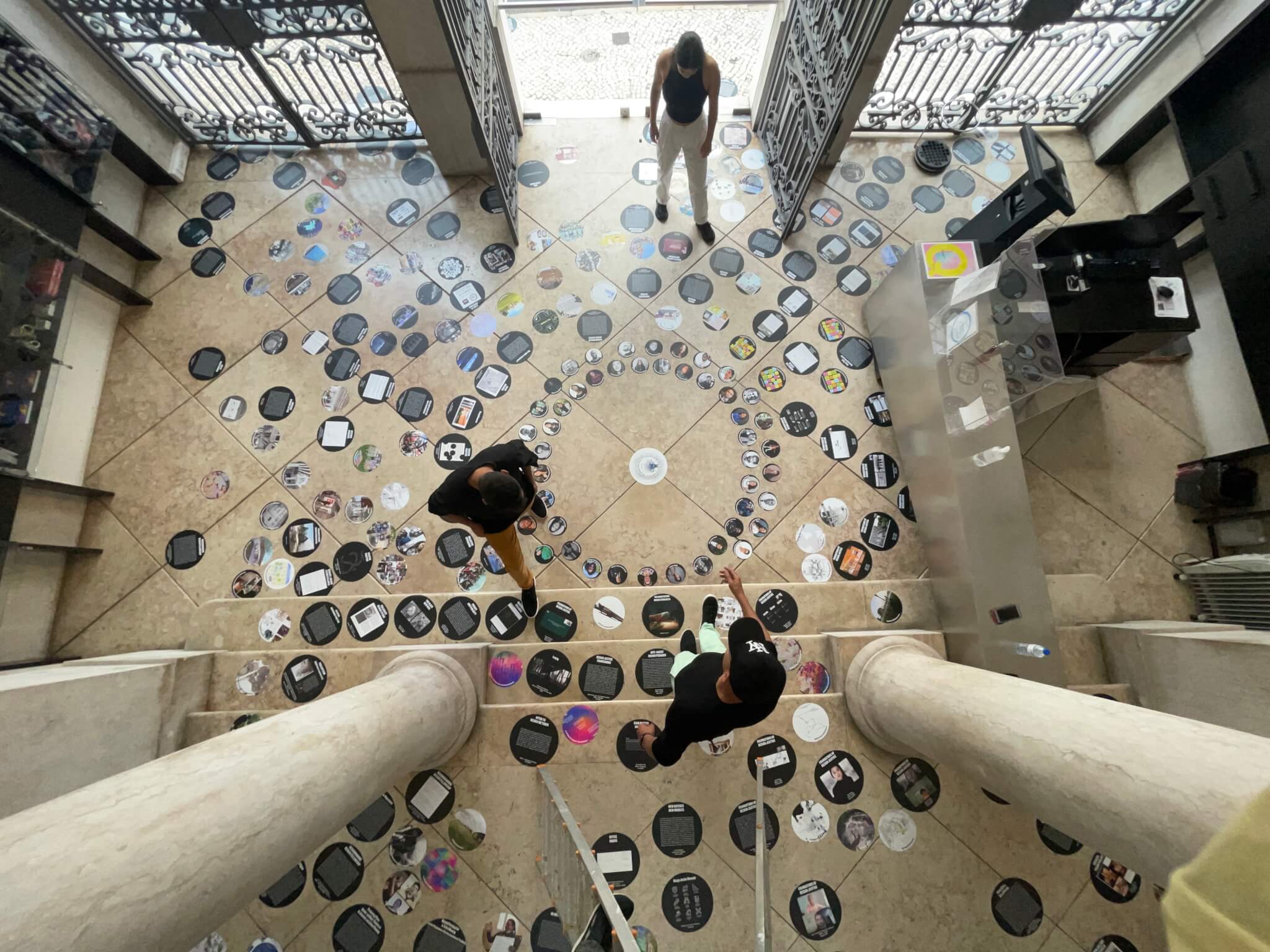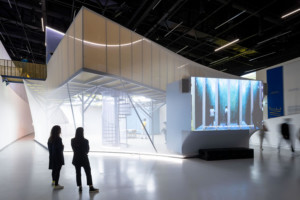Terra
Lisbon Architecture Triennale
Various locations
Lisbon, Portugal
Open through December 5
On November 1, 1775, one of the largest earthquakes in recorded history decimated Lisbon. Buildings collapsed and opened fissures into the earth. The epicenter of this seismic event was off the coast under the Atlantic Ocean, and 40 minutes later a tsunami swept up the Tagus River, inundating survivors. It was All Saints Day, and candles had been lit in remembrance; their flames, when toppled during the quake, engulfed the city in a powerful firestorm. Eventually, 85 percent of the city was destroyed. The incident required Lisbon’s reconstruction, resulting in the gridded baixa central district with buildings realized in what came to be known as the Pombaline style, which incorporated prefabricated, anti-seismic elements and tall wood foundation piers. The redo worked: In 2017, Lisbon’s newish downtown was listed as a UNESCO World Heritage Site.
This fall, Lisbon again sports an event of earth-moving significance with Terra, the sixth iteration of the Lisbon Architecture Triennale, which, in this current formulation, focuses on how we interact with our shared home of Planet Earth. The effort is chief-curated by Cristina Veríssimo and Diogo Burnay, architects and academics who lead the office CVDB Arquitectos and have taught in varying capacities at schools around the world.
“Terra is, above all, a global call to a sense of urgency. It’s a call to action,” they declared during the program’s opening events. We ought to unlearn linear concepts of production, they argue, and embrace the circularity of citymaking. Faced with the layer crises of contemporary life, how do architects respond to make improvements, both for human constituents and broader biotic communities? The production, in the words of its curators, “suggests that the future should be reassessed by intersecting and exchanging knowledge and practices that are capable of coexisting, contributing to a more sustainable future for the planet and all its inhabitants.”
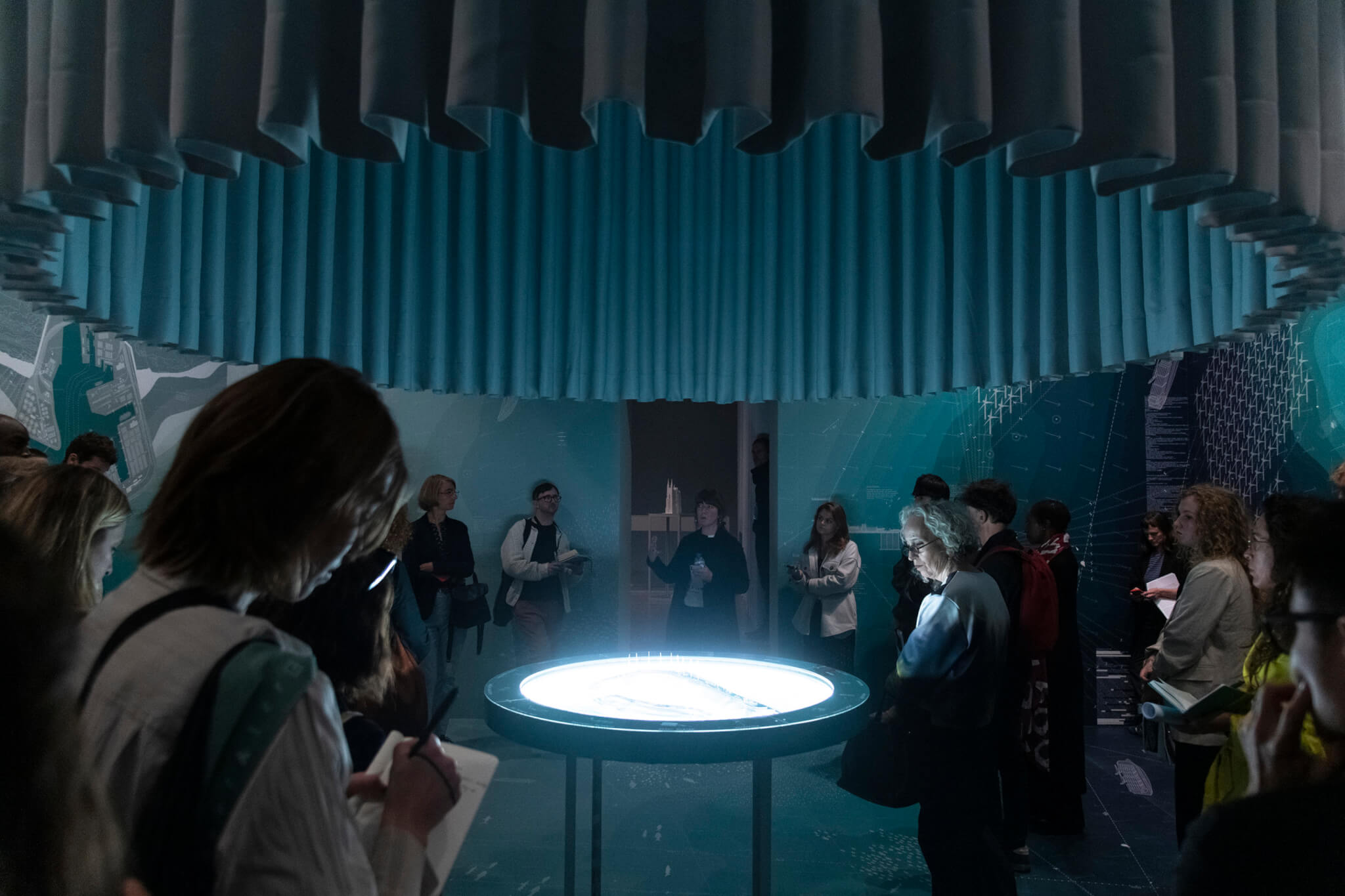
The claim is timely, but beyond performative statements, how to live up to such a tall order? To start, rather than stuffing a sprawling convention center (or arsenale) with a parade of paper projects, the chief curators split the event into four main exhibitions with a series of supporting shows, talks, awards, and publications. (This strategy was used for the prior instances of the triennale, previously curated by Beatrice Galilee, André Tavares, Diogo Seixas Lopes, and Éric Lapierre, each with a host of curatorial team members.) This reflects not only the available venues for architectural exhibitions in the city (and in nearby Belém, to the west), but it makes good on the show’s thematic commitment to a choir of voices sounding the alarm.
The curators of each sub-exhibition established an agenda and set about defining their own shows, with three shows led by duos. Each, addressed below, charts its own territory. While they’re mutually reinforcing, it’s also clear they’re spaced out in an attempt to give each its own realm of operation. Thankfully, the show is consistently–and healthily–post-form, meaning that contexts, materials, and publics are more important than the contortions of individual projects. This descriptor should come as no surprise, as considerable energy lately is directed towards the politics, effects, and audiences of architecture rather than its shapes.

Terra, taken together, is projective rather than critical. Instead of railing against the various forces that led to our current predicament, its contents demonstrate strategies for survival.
It joins a season of European architecture exhibitions in which the “social turn” in subject matter is notable, welcomed, and overdue: Oslo’s triennale worked at the scale of the neighborhood, Rotterdam’s biennale went straight to climate change’s root cause of economic growth, and Tallinn, Estonia’s biennale Edible; or, the Architecture of Metabolism focused on food. Next year’s showing at Venice, curated by Lesley Lokko and focusing on Africa as a laboratory of the future, stands to further advance these arrayed, interconnected concerns.

Visionaries
Installed on a basement level of Culturgest, an arts center within the headquarters of Caixa Geral de Depósitos, Portugal’s largest bank, Visionaries boasts the most star power of the four shows. Curated by Anastassia Smirnova with SVESMI, the office she runs with Alexander Sverdlov, the installation examines different ways to image the future, from the “monovisionaries” we know too well to more distributed planetary strategies. Of particular use is the curator’s coinage of the phrase “cathedral thinking,” which describes the ethics of working as one of many authors on something you won’t live to see the end of. It suggests a belief in design as an ongoing, shared process of creation.

Early in the show, Roger Anger’s Auroville is set up as an “old,” singular idea of the future, but here this reputation is augmented by Indian architect Anupama Kundoo’s more recent work on its master plan. In a particularly impressive room themed on isolation, a presentation of Ensamble Studio’s Ca’n Terra house in Menorca is staged against homes by the Japanese architect Tomoaki Uno, and watercolors of the Soviet space program by Russian architect Galina Balashova. In another, artifacts from Dom Hans van der Laan’s Roosenberg Abbey are installed with a loop of video portraits by the artist Nuno Cera, who also shot footage at Andrés Jaque’s Run Run Run “hybrid infrastructure” in Madrid and Selgascano’s Second Home coworking venture in Los Angeles.

A full room is dedicated to the ORG Permanent Modernity’s research on maritime systems, here translated into four walls of drawings and a glowing central model. Next door, MVRDV’s insane proposal to raise St. Catherine’s church in Eindhoven into the air and rebuild top-dollar real estate underneath is set against bplus.xyz’s (Arno Brandlhuber’s) conversion of two concrete towers in Berlin into homes and offices. Throughout, BUREAU’s effective exhibition design closes off rooms with a platoon of gray curtains and, upon ramped approach, sets the scene with a purple neon sign.
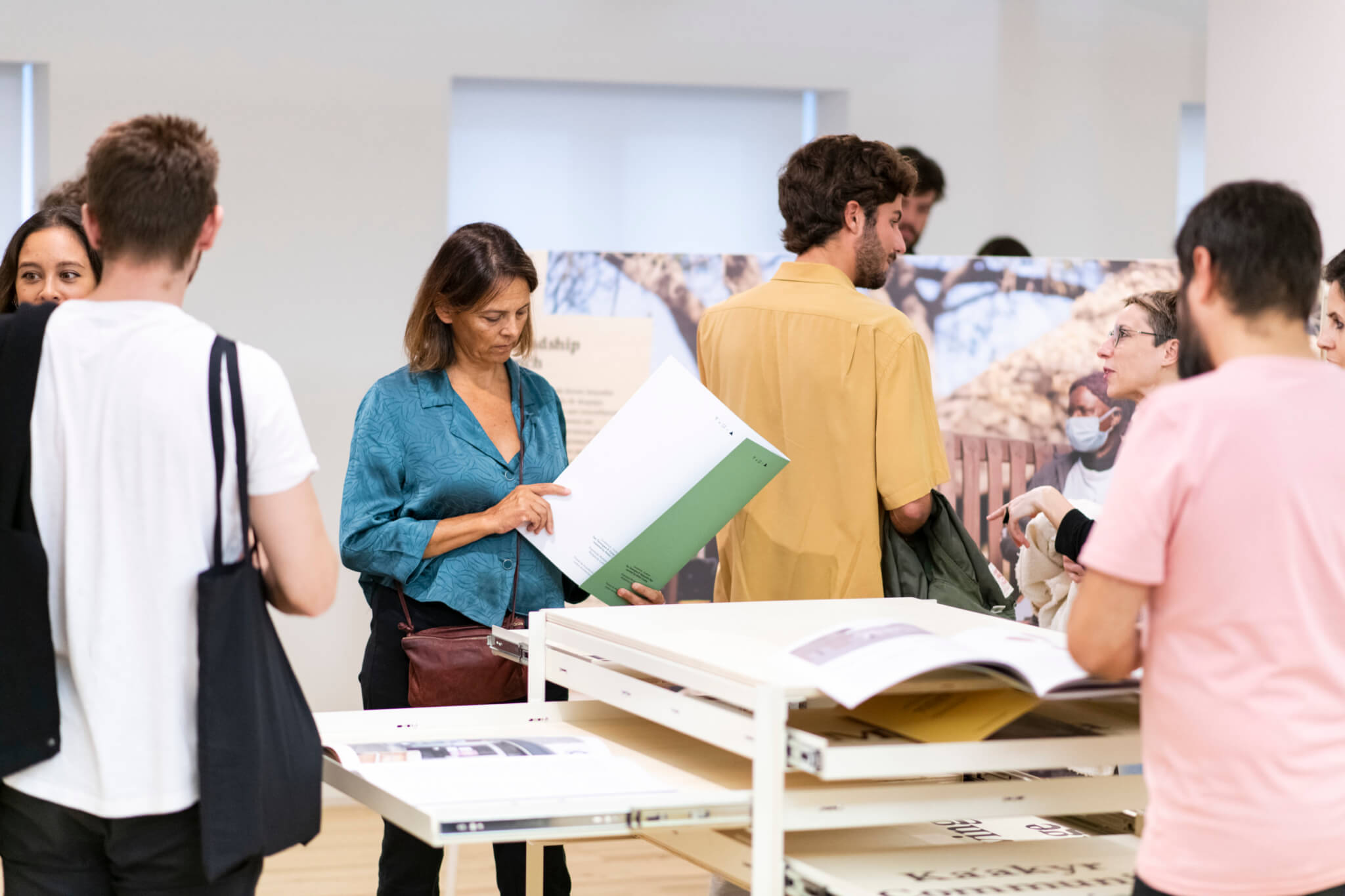
Multiplicity
Curated by Tau Tavengwa and Vyjayanthi Rao, the Zimbabwe-born founder and coeditor of Cityscapes magazine and the director of the Terreform Center for Advanced Urban Research, respectively, this exhibition focuses on projects from the Global South that respond to the layered crises of inequality, climate change, and conflict with tools that “build social muscles.”
From the encouraging spread, highlights include Torolab’s work in Tijuana, where the arts collective, led by Raúl Cárdenas Osuna, has operated La Granja Transfronteriza since 2010 (“I realized architecture was a beautiful form of art that doesn’t matter,” Cárdenas said in 2016); the Casa do Vapor, a settlement across the river from Lisbon which realized community structures for collective life; and the community fridges of Jackson Heights, where during the height of the pandemic, Latina women coordinated mutual care through Google Sheets. The offerings consistently demonstrated how construction—by architects and everyday people alike—can be used as a support for societal improvement.
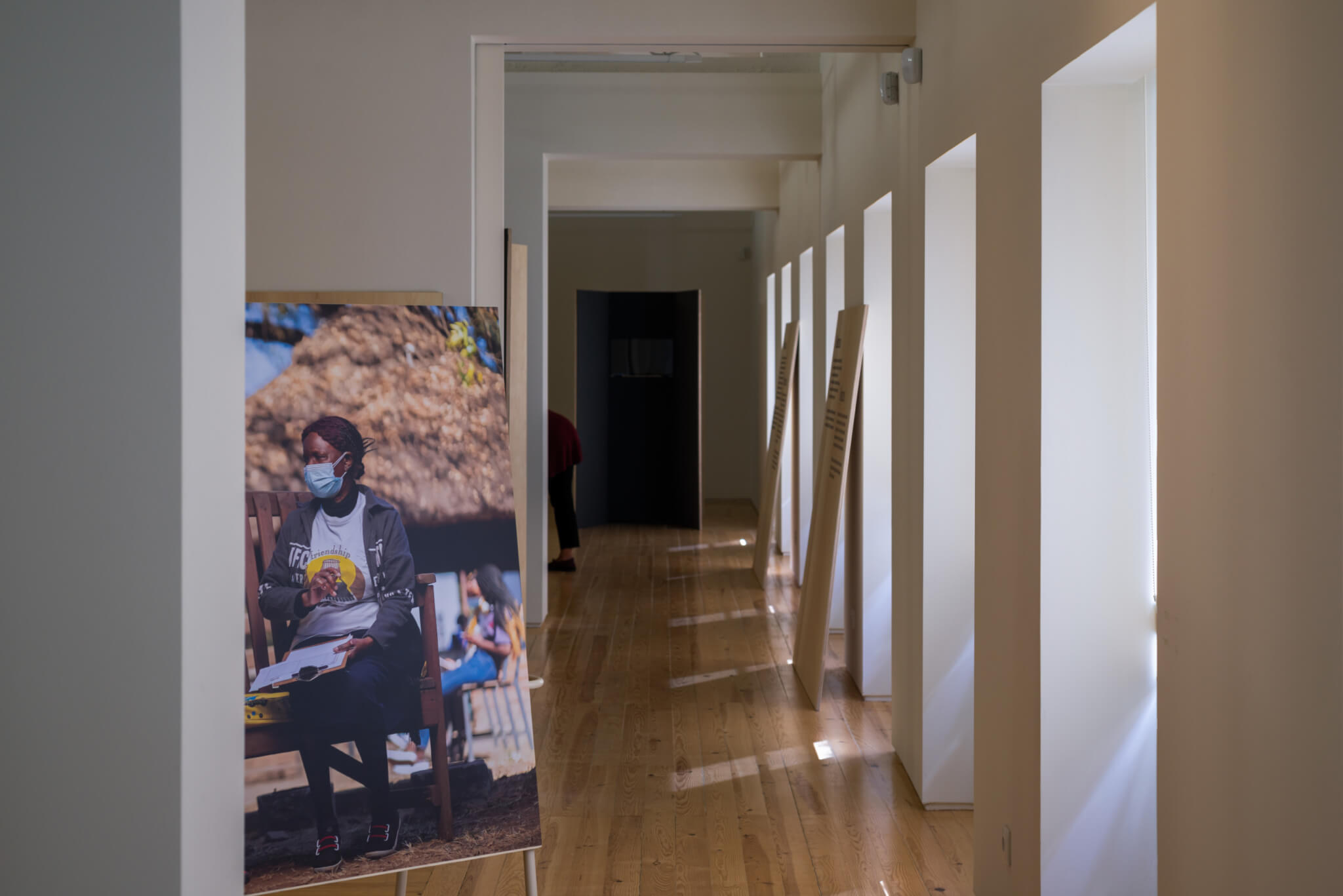
In a design by Miguel Vieira Baptista, the show’s contents are on display in a series of archival carts, which store books and printed matter, and tables, which support models, most prominently one of the Bookworm Pavilion by Indian architecture office Nudes. The sliding drawers make exploring Multiplicity’s contents more like scholastic research than a museum experience, which makes sense as both curators are writers. Large photographic prints anchor key projects with imagery, and throughout the galleries, tall totems with built-in speakers murmur advice from inspirational figures; they’re portable, too.

Multiplicity suffers from its staging at the back of the top floor of the National Museum of Contemporary Art in Chiado; it’s a trek to get there through the galleries, and by square footage it feels smaller than the other venues. As a teaser of sorts, one project was given prominent billing in the museum’s lobby. There, a radial spread of stickers visualizes the work of Dark Matter University, an entity of architecture instructors leading change towards antiracist modes of education and practice. The organization seeks not canons but constellations, and it works to center new subjectivities and identities within a discipline that, intentionally or not, historically advanced whiteness. This first version of a living archive captures individuals, classes, and collaborations and is supplemented by a VR app which spatializes the installation into a 3D web of linkages. (A version also appears on the organization’s website.) The dots even manage to slip under the museum’s glass door onto the limestone calçada beyond.

Retroactive
Central Tejo, built in 1908, was a riverfront thermal power plant until its decommissioning and reopening as a museum in 1990. It’s now part of the EDP Foundation campus, which also includes the Museum of Art, Architecture and Technology (MAAT), designed by AL_A (Amanda Levete Architects). EDP, an electric utility company, is a strategic partner of the triennale. (In 2020, its portfolio consisted of 74 percent renewable energy, and the company is aiming for 100 percent by 2030.)
Inside MAAT’s power plant, a large gallery houses Retroactive, curated by Loreta Castro Reguera and José Pablo Ambrosi of Mexico City–based Taller Capital. The collection centers engagements with “broken cities” worldwide that install new infrastructures into existing environments. While reminiscent of an earlier zeitgeist when architects “discovered” informal settlements and set about researching them, this show is much better, as most designers are working with local communities. These projects engage territories and as such expand far beyond typical architectural scales and utilize a wide range of forms of representation, including models mixed with video projections.

CASCA Arquitectura e Design’s exhibition uses soil-weighted landscape fabric as a spacemaking device and surface of projection. A darkened room sports a jumble of videos, a following tight set of walls supporting framed images, and a row of plinths—set at coffee table level and haloed in fabric—showcases projects by architects like Estudio Teddy Cruz + Fonna Forman. (Other notable contributing offices include Colectivo C733, Rural Urban Framework, OOZE, and Base Urbana + Pessoa Arquitetos.) The displays (and boards, which line a long wall) require close attention to fully absorb; some larger items might’ve helped break up the pacing of all the fine work.
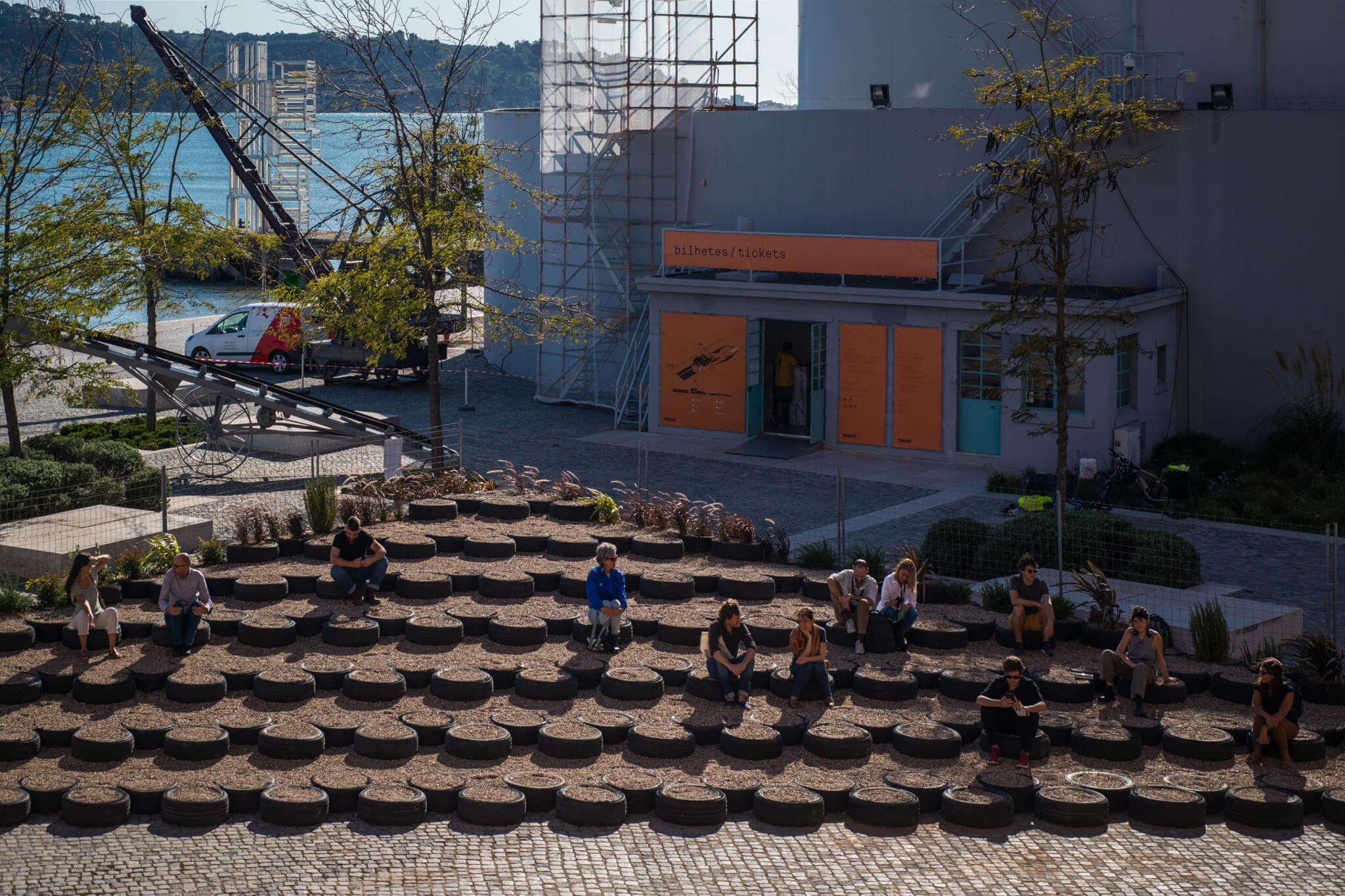
The curators go big on the outdoor plaza: A triangle of old tires wedges upwards, creating a bleacher stair facing the historic building. It turns the paved expanse into a place for talks or performances. The tires, shipped in from Tijuana, powerfully demonstrate Retroactive’s ambit. It matters because, as the curators note, a third of the population lives in cities like these, each in need of infrastructural improvement.

Cycles
Philosopher Pamela Prado and architect Pedro Ignacio Alonso, both from Chile, curated this display, which considers flows of materials over time and works with the idea of storage and the “aesthetics of the warehouse” to lay out a spacious room of objects, mockups, books, and art. The pieces benefit from their generic locale, a windowless sub-level of the Centro Cultural de Belém called Garagem Sul. Outside on a plaza, a greenhouse skinned in red-tinted plastic by Chilean artist Patrick Hamilton is “about capitalism” as it skews vision to simulate global warming.
Rather than buildings becoming waste, the curators argue for locating structures within cyclical processes, namely of material, which is the key concern of the show. Apart from select models and fragments, piles of wood, stone, and elements are organized on pallets. One notable research effort was a full mockup of a thatch and clay wall assembly by Anne Beim from the Royal Danish Academy of Fine Arts; it takes a vernacular process and studies it for low-carbon, fire-resistant improvements.
The organizational imperative is clear in its subtitle: “The Architects Who Never Threw Anything Away.” It takes inspiration from “The Man Who Never Threw Anything Away,” a short story by artist Ilya Kabakov. A shingled wall of newsprint leaflets of the tale—in Portuguese and English and designed by Pozo Marcic Ensamble—hang in a circular gallery, free for the taking. Classification, order, storage, and archival methods are key topics: The engaging show, which will remain on view through February 12, 2023, feels more like a salvaged goods supply store than an exhibit.

While still hosting projects by architects like Ambrosi Etchegaray, Lydia Kallipoliti, and Charlotte Malterre-Barthes, the work coheres better than in other shows, though maybe this is just the result of the open, parking garage–like interior. (Rar.studio’s exhibition design also handles content with a light “in progress” touch using purple drywall and light-gauge metal framing.) To close, Spanish artist Lara Almarcegui mounds up a giant pile of raw cork. Its presence, smell, and texture reminds viewers about the actual organic items that are wrangled into making buildings. Rather than showcasing media that depicts architecture, Cycles shows what architecture is really made from.
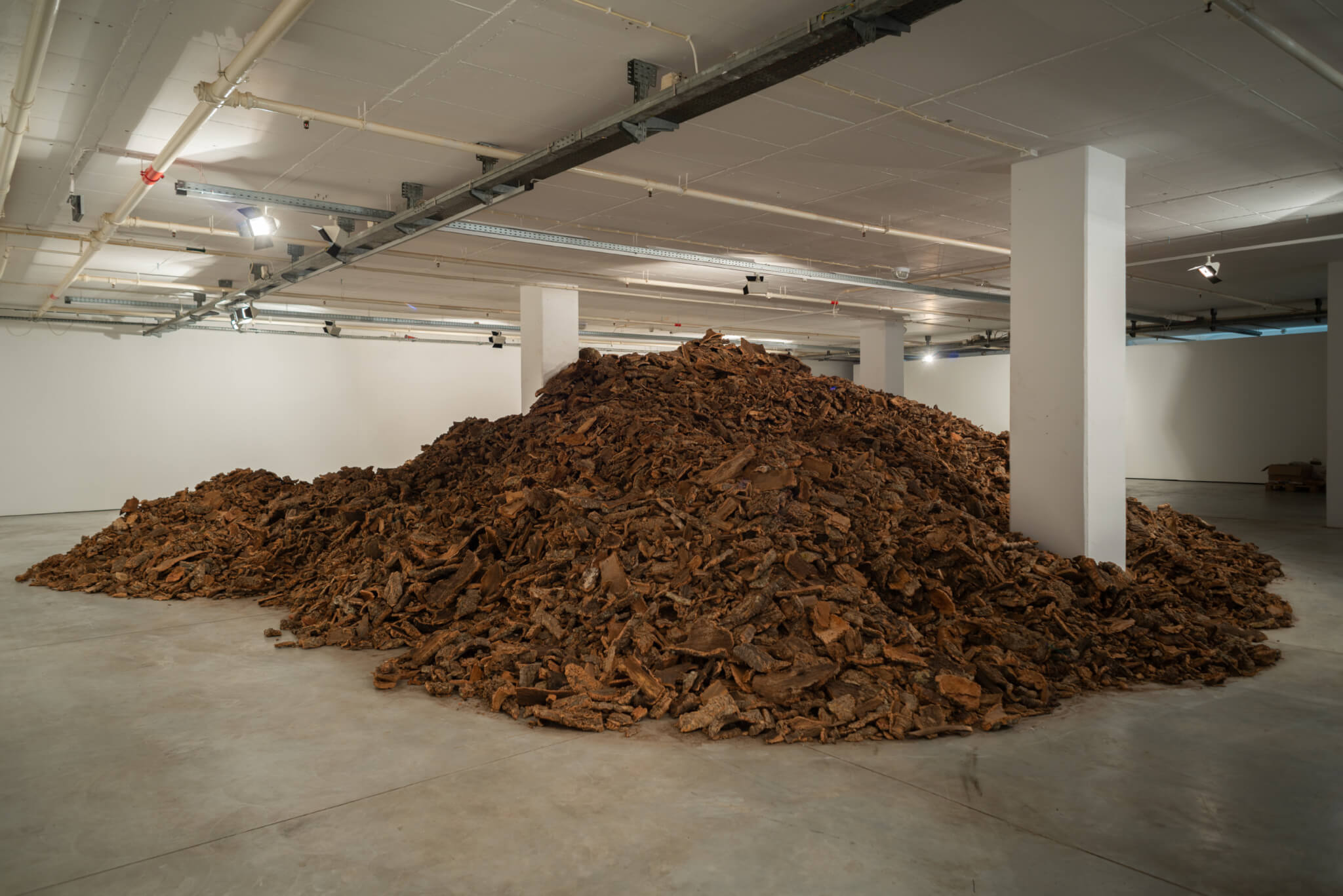
Elsewhere
Terra also sprouts a crop of other activity, including six smaller independent projects realized in two sets of three on the upper floor of the Palácio Sinel de Cordes (the first set included work by Lodgers, After Plastics, and Joyce Hsiang and Bimal Mendis of Plan B Architecture & Urbanism); still other projects, largely from universities, at other venues; a weekend of talks at the Gulbenkian Foundation; a quartet of awards; and four “pocket-size” books. It’s difficult to land on one defining image of the exhibitions. Upon exit and further reflection the overall sense—and, largely, of today’s zeitgeist—is one of socially concerned, step-by-step efforts, with space making proceeding in line with wider cultural advances.
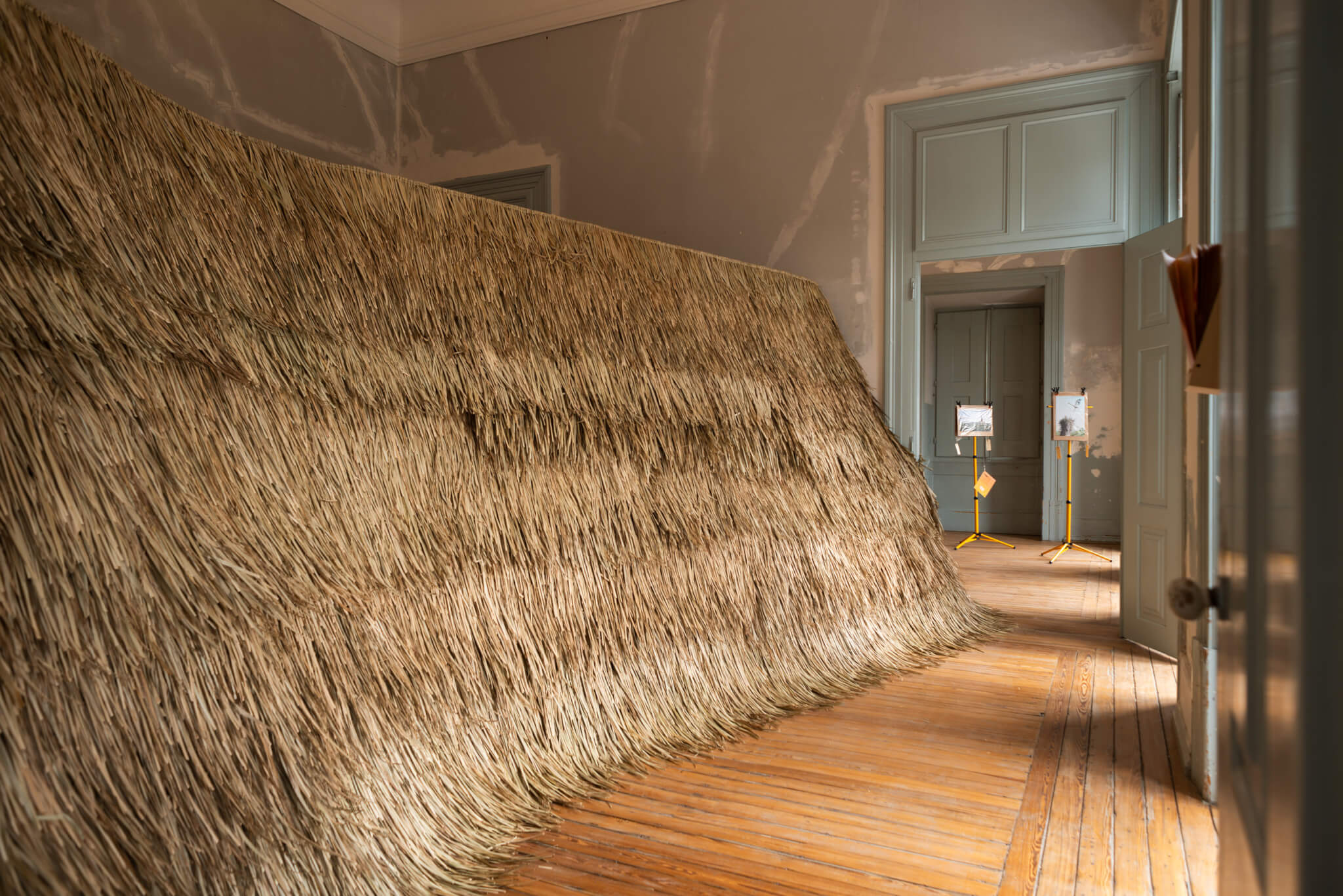
In addition to the reconstruction of Lisbon, the 1755 earthquake proved transformational for European culture. Catholics took it as a sign of God’s punishment for sinful excesses derived from over two centuries of extractive colonialism in the Americas, Africa, and India, and protestants, though they celebrated the literal collapse of the house of the Inquisition, saw it as a chance to question the Enlightenment’s explanations of natural phenomena. The doubt-inducing disaster figured prominently in Voltaire’s Candide, and Immanuel Kant published three texts about it, proffering (erroneous) theories about its causes. Still, the episode likely comprises the beginning of seismology (according to Walter Benjamin, who took up the event in 1931 radio program for children) and proved to be a turning point in scientific history.
What will be the effect of the shock waves sent out by today’s Terra? Surely it heralds a rhizomatic understanding of humanity’s ability to counteract the worst results of our Anthropocenic plight. If destruction (or its threat) is nearly everywhere–much like the earthquake’s effects–then so too is our collective sense of being first responders in a slow-moving disaster scenario. And, as Rebecca Solnit reminds us in A Paradise Built in Hell, intensive moments like this one forge new relationships of care and solidarity.
Through its detailed, distributed showcases, Terra stocks the pond with a set of architects whose work prizes the planet and its biotic life. If only more people in power operated with such consideration! It’s no small thing to, in a city that has been inhabited for over 2,000 years, be given a glimpse of the future.








